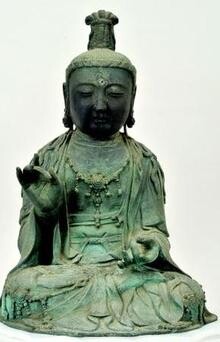hankyoreh
Links to other country sites 다른 나라 사이트 링크
Court rules that ancient Buddhist statue can remain in Korea

When a Buddha statue taken from Korea hundreds or years before is stolen back from Japan, who should it be returned to?
In Oct. 2012, a gilt bronze statue of the seated Guanyin stolen from Kannon Temple on Japan’s Tsushima Island was confiscated when a group of cultural heritage thieves, including a 74-year-old surnamed Kim, attempted to smuggle it into South Korea. Now a court’s decision has offered an answer on the resulting ownership controversy.
Judge Moon Bo-gyeong of the 12th civil affairs division at Daejeon District Court ruled in favour of the plaintiffs on Jan. 26 in a case filed against the government by the Jogye Order of Korean Buddhism’s Buseok Temple to request transfer of the statue to its ownership, ordering the delivery of the statue to the temple.
The court also said it would allow provisional execution, deeming the temple to have “sufficient capacity to store the gilt bronze bodhisattva statue.”
“Inspection of the dress and relics associated with the statue, which was discovered in 1951 by the head monk at Japan’s Kannon Temple, shows a record stating that ‘32 people in Seoju in the kingdom of Goryeo [as Korea was called at the time] made the statue and enshrined it at Buseok Temple in year 3 of the heavenly calendar (1330),’ where Seoju is the Goryeo-era name for Seosan [a county in South Chungcheong Province],” the ruling said.
“As the Jogye Order states that the Buseok Temple in Seosan is the same Buseok Temple in Seoju during the Goryeo era, Buseok Temple is the original owner of the gilt bronze statue,” it concluded.
The court went on to note that “new gilding of the Buddha statue and any repairs or relocations are indicated in the dress and relics.”
“Because the dress and relics discovered in 1951 records the making of the statue rather than its relocation, it is unlikely that it was delivered to Japan through a normal exchange process,” it added.
“Research records show that Kannon Temple was established in 1526 as part of the Buddhist practice of Morichika Konoheisaemon, the head of a group of Japanese raiders that committed atrocities in Joseon,” the court continued.
“The statue has no jeweled crown on its head and bears traces of fire damage. It is therefore suspected that the presence in Kannon Temple of a Buddha statue enshrine at Buseok Temple was the result of plundering by Japanese raiders, and the statue must therefore be seen as the property of Buseok Temple,” it concluded.
Buseok Temple head monk Won-woo praised the court for its “wise decision based on historical fact.”
“I look forward to this being the beginning of recovery for the more than 70,000 pieces of cultural heritage suspected of having been illegally lost to Japan,” he continued, adding that the order “plans to enshrine the statue at the main Sudeok Temple’s Seongbo Museum once the ruling has been received.”
The statue, which measures 50.5 cm in height and weighs 38.6 kilograms, was deigned a Tangible Cultural Property in Japan in 1973. Kannon Temple requested its return as stolen cultural property after Kim and the other thieves were arrested. A controversy between South Korea and Japan ensued when Buseok Temple countered that the statue had been plundered and should be returned to its original owner.
In a regular press conference on Jan. 26, Japanese Chief Cabinet Secretary Yoshihide Suga said, “We find this decision extremely regrettable and will demand appropriate action from South Korea so that the statue is returned to Japan swiftly.”
By Song In-geol and Gil Yun-hyung, Daejeon and Tokyo correspondents
Please direct questions or comments to [english@hani.co.kr]

Editorial・opinion
![[Column] Tariffs on China: Trump was dumb, Biden dumber [Column] Tariffs on China: Trump was dumb, Biden dumber](https://flexible.img.hani.co.kr/flexible/normal/500/300/imgdb/original/2024/0520/191716191153918.jpg) [Column] Tariffs on China: Trump was dumb, Biden dumber
[Column] Tariffs on China: Trump was dumb, Biden dumber![[Column] What if Seoul took reunification by force off the table? [Column] What if Seoul took reunification by force off the table?](https://flexible.img.hani.co.kr/flexible/normal/500/300/imgdb/original/2024/0520/3017161928630494.jpg) [Column] What if Seoul took reunification by force off the table?
[Column] What if Seoul took reunification by force off the table?- [Editorial] Intensifying US-China rivalry means Seoul must address uncertainty with Beijing sooner than later
- [Column] When ‘fairness’ means hate and violence
- [Editorial] Yoon must stop abusing authority to shield himself from investigation
- [Column] US troop withdrawal from Korea could be the Acheson Line all over
- [Column] How to win back readers who’ve turned to YouTube for news
- [Column] Welcome to the president’s pity party
- [Editorial] Korea must respond firmly to Japan’s attempt to usurp Line
- [Editorial] Transfers of prosecutors investigating Korea’s first lady send chilling message
Most viewed articles
- 1Xi, Putin ‘oppose acts of military intimidation’ against N. Korea by US in joint statement
- 2Kim Jong-un wanted to meet with residents of shelled Yeonpyeong Island in South, Moon recalls in mem
- 3For new generation of Chinese artists, discontent is disobedience
- 4Berlin mayor hints at tearing down ‘comfort women’ memorial in city
- 5[Column] What if Seoul took reunification by force off the table?
- 6To weigh costs and benefits, Korea must stop treating US troop presence as a sacred cow
- 7[Column] Tariffs on China: Trump was dumb, Biden dumber
- 8China, Russia put foot down on US moves in Asia, ratchet up solidarity with N. Korea
- 9Putin’s trip to China comes amid 63% increase in bilateral trade under US-led sanctions
- 10[Exclusive] Unearthed memo suggests Gwangju Uprising missing may have been cremated